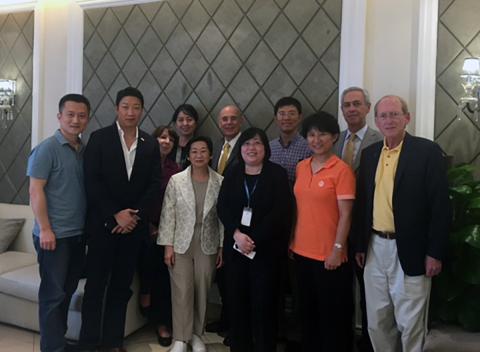Two years ago, Georgia Tech became the first American institution to become a member of Shenzhen Virtual University Park. Similar to the Georgia Tech/Tech Square model back home in Atlanta, the Shenzhen Virtual University Park emphasizes university-industry partnerships. Even though we are just beginning to settle into our new role in Shenzhen, we are already talking about bringing the effort to the next level.
Just 35 years ago, Shenzhen was basically a fishing village. Now the region is an amazing metropolis and the technology business center of China. I was told that at one point they were building one high rise building per day! I cannot vouch for that statement, but it is believable. Shenzhen is in the mainland, just a short drive from Hong Kong, across extraordinary roads and bridges that were not there before this recent transformation.
Two years ago, Georgia Tech became the first American institution to become a member of Shenzhen Virtual University Park. Similar to the Georgia Tech/Tech Square model back home in Atlanta, the Shenzhen Virtual University Park emphasizes university-industry partnerships. A single facility houses educational institutions, startups, and established companies.
We moved to Shenzhen after years of offering masters degrees in Shanghai. That program was very successful; its “Coulter Fellows” graduates are already doing amazing things in industry and academia. With the Coulter Foundation support, we were able to educate many who could not otherwise afford quality education. Moving to Shenzhen involved risks but continues to offer enormous opportunities. We began by offering a Master of Science in Electrical and Computer Engineering. We are proud that the program was the first Chinese Ministry of Education-approved program in Shenzhen offered by a U.S. university. Current students in that program hail from mainland China, the U.S., Taiwan, France, India, and Indonesia. Our programs in China are under the extraordinary leadership of Prof. G. Tong Zhou. Without her energy and vision none of our activities would be possible.
The challenge in China is: you do not walk, you must run all the time. Even though we are just beginning to settle into our new role in Shenzhen, we are already talking about bringing the effort to the next level. We are speaking to partners in Tianjin University – a well-established, technology-oriented institution in China – about co-locating our activities and increasing collaboration in brand new facilities in Shenzhen under the auspices of the Shenzhen Education Bureau. With that possibility in mind, we met for over three hours with leadership of the Shenzhen Education Bureau who would be the sponsors of the endeavor.
We also toured four sites where the facilities are being offered as possible “homes.” It is difficult to describe what we saw. They ranged from multibillion dollar science and industrial parks – brand new, self-contained cities, still being built; to facilities that were once a resort largely used for government officials (lakes and all) and very close to what is called “University City” that houses Shenzhen campuses of Chinese institutions like Tsinghua University of Beijing; to a self-contained living, leisure resort with everything from 12 golf courses to and international school for children – I have never seen anything quite like it before.
Now we head for Shanghai, very familiar stomping grounds for Georgia Tech. I hope to tell you more about our trip from our meetings and events there.
- Rafael L. Bras
Photo above (from left to right): Ning Chen (PhD ECE 2006); Shelton Chan (MS IL 2003), Asia Pacific, managing director of development; Marta Garcia, associate vice president for development; Ziling Huo, vice president of Mindray; Sue Van (Hon. PhD - Georgia Tech); Rafael L. Bras, provost and executive vice president for academic affairs; Patricia Chew, vice president of human resources, Walmart China; John Zhong (MS EE '88), chief executive officer of Amlogic; Professor Tong Zhou; Professor Yves Berthelot; and Professor George Riley (PhD 2001).
